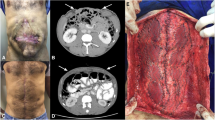Abstract
Background
Postoperative fascial dehiscence and open abdomen are severe postoperative complications and are associated with surgical site infections, fistula, and hernia formation at long-term follow-up. This study was designed to investigate whether intraperitoneal implantation of a composite prosthetic mesh is feasible and safe.
Methods
A total of 114 patients with postoperative fascial dehiscence and open abdomen who had undergone surgery between 2001 and 2009 were analyzed retrospectively. Contaminated (wound class 3) or dirty wounds (wound class 4) were present in all patients. A polypropylene-based composite mesh was implanted intraperitoneally in 51 patients, and in 63 patients the abdominal wall was closed without mesh implantation. The primary endpoint was incidence of incisional hernia, and the incidence of enterocutaneous fistula was a secondary endpoint.
Results
The incidence of enterocutaneous fistulas after wound closure post-fascial dehiscence (13% vs. 6% without and with mesh, respectively) or post-open abdomen (22% vs. 28% without and with mesh, respectively) was not significantly different. The incidence of incisional hernia was significantly lower with mesh implantation compared with no-mesh implantation in both contaminated (4% vs. 28%; p = 0.025) and dirty abdominal cavities (5% vs. 34%; p = 0.01).
Conclusions
Intra-abdominal contamination is not a contraindication for intra-abdominal mesh implantation. The incidence of enterocutaneous fistula is not elevated despite the presence of contamination. The rate of incisional hernias is significantly reduced after intraperitoneal mesh implantation for postoperative fascial dehiscence or open abdomen.

Similar content being viewed by others
References
Bucknall TE, Cox PJ, Ellis H (1982) Burst abdomen and incisional hernia: a prospective study of 1129 major laparotomies. Br Med J (Clin Res Ed) 284:931–933
Seiler CM, Bruckner T, Diener MK et al (2009) Interrupted or continuous slowly absorbable sutures for closure of primary elective midline abdominal incisions: a multicenter randomized trial (INSECT: ISRCTN24023541). Ann Surg 249:576–582
van Ramshorst GH, Eker HH, Harlaar JJ et al (2010) Therapeutic alternatives for burst abdomen. Surg Technol Int 19:111–119
Madsen G, Fischer L, Wara P (1992) Burst abdomen–clinical features and factors influencing mortality. Dan Med Bull 39:183–185
Tremblay LN, Feliciano DV, Schmidt J et al (2001) Skin only or silo closure in the critically ill patient with an open abdomen. Am J Surg 182:670–675
Moussavian MR, Schuld J, Dauer D et al (2010) Long-term follow-up for incisional hernia after severe secondary peritonitis-incidence and risk factors. Am J Surg 200:229–234
Verdam FJ, Dolmans DE, Loos MJ et al (2011) Delayed primary closure of the septic open abdomen with a dynamic closure system. World J Surg 35:2348–2355
Esmat ME (2006) A new technique in closure of burst abdomen: TI, TIE and TIES incisions. World J Surg 30:1063–1073
Leppaniemi A, Tukiainen E (2012) Planned hernia repair and late abdominal wall reconstruction. World J Surg 36:511–515
Marwah S, Marwah N, Singh M et al (2005) Addition of rectus sheath relaxation incisions to emergency midline laparotomy for peritonitis to prevent fascial dehiscence. World J Surg 29:235–239
Acosta S, Bjarnason T, Petersson U et al (2011) Multicentre prospective study of fascial closure rate after open abdomen with vacuum and mesh-mediated fascial traction. Br J Surg 98:735–743
Balique JG, Benchetrit S, Bouillot JL et al (2005) Intraperitoneal treatment of incisional and umbilical hernias using an innovative composite mesh: four-year results of a prospective multicenter clinical trial. Hernia 9:68–74
Bee TK, Croce MA, Magnotti LJ et al (2008) Temporary abdominal closure techniques: a prospective randomized trial comparing polyglactin 910 mesh and vacuum-assisted closure. J Trauma 65:337–342 discussion 342-334
Sutton R, Bann S, Brooks M et al (2002) The Surgical Risk Scale as an improved tool for risk-adjusted analysis in comparative surgical audit. Br J Surg 89:763–768
Mangram AJ, Horan TC, Pearson ML et al (1999) Guideline for prevention of surgical site infection, 1999. Centers for disease control and prevention (CDC) Hospital infection control practices advisory committee. Am J Infect Control 27:97–132 quiz 133-134; discussion 196
Mingoli A, Puggioni A, Sgarzini G et al (1999) Incidence of incisional hernia following emergency abdominal surgery. Ital J Gastroenterol Hepatol 31:449–453
Mughal MM, Bancewicz J, Irving MH (1986) ‘Laparostomy’: a technique for the management of intractable intra-abdominal sepsis. Br J Surg 73:253–259
Teixeira PG, Salim A, Inaba K et al (2008) A prospective look at the current state of open abdomens. Am Surg 74:891–897
DiCocco JM, Magnotti LJ, Emmett KP et al (2010) Long-term follow-up of abdominal wall reconstruction after planned ventral hernia: a 15-year experience. J Am Coll Surg 210:686–695–695-688
Connolly PT, Teubner A, Lees NP et al (2008) Outcome of reconstructive surgery for intestinal fistula in the open abdomen. Ann Surg 247:440–444
Burger JW, Luijendijk RW, Hop WC et al (2004) Long-term follow-up of a randomized controlled trial of suture versus mesh repair of incisional hernia. Ann Surg 240:578–583 discussion 583-575
Leber GE, Garb JL, Alexander AI et al (1998) Long-term complications associated with prosthetic repair of incisional hernias. Arch Surg 133:378–382
Bosscha K, Hulstaert PF, Visser MR et al (2000) Open management of the abdomen and planned reoperations in severe bacterial peritonitis. Eur J Surg 166:44–49
Tsuei BJ, Skinner JC, Bernard AC et al (2004) The open peritoneal cavity: etiology correlates with the likelihood of fascial closure. Am Surg 70:652–656
Anderson O, Putnis A, Bhardwaj R et al (2010) Short and long term outcome of laparostomy following intra-abdominal sepsis. Colorectal Dis 13(2):e20–e32
Subramonia S, Pankhurst S, Rowlands BJ et al (2009) Vacuum-assisted closure of postoperative abdominal wounds: a prospective study. World J Surg 33:931–937
Cobb WS, Carbonell AM, Kalbaugh CL et al (2009) Infection risk of open placement of intraperitoneal composite mesh. Am Surg 75:762–767 discussion 767-768
Brooks MJ, Sutton R, Sarin S (2005) Comparison of Surgical Risk Score, POSSUM and p-POSSUM in higher-risk surgical patients. Br J Surg 92:1288–1292
Conflicts of interest
None.
Funding
None.
Author information
Authors and Affiliations
Corresponding author
Rights and permissions
About this article
Cite this article
Scholtes, M., Kurmann, A., Seiler, C.A. et al. Intraperitoneal Mesh Implantation for Fascial Dehiscence and Open Abdomen. World J Surg 36, 1557–1561 (2012). https://doi.org/10.1007/s00268-012-1534-z
Published:
Issue Date:
DOI: https://doi.org/10.1007/s00268-012-1534-z




